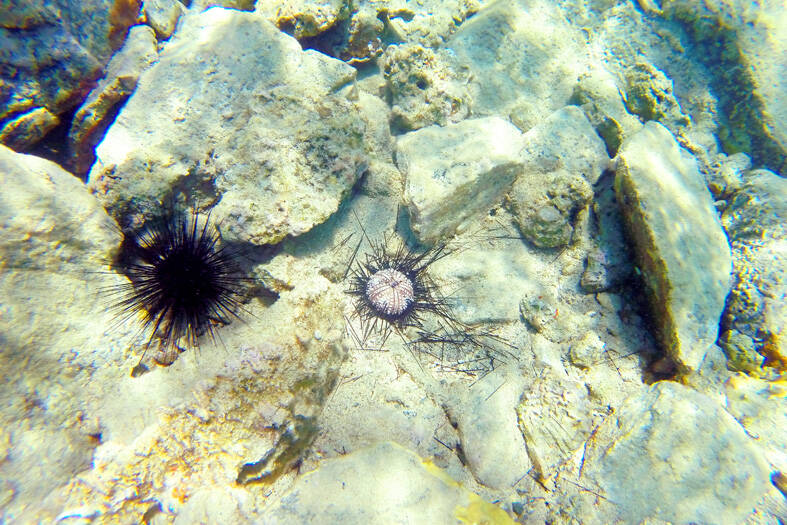Marine biologists at a Florida university said they have solved the mystery of a mass die-off of long-spined sea urchins from the US to the Caribbean.
The scientists blamed a microscopic, single-cell parasite for the die-off, which took hold early last year. Affected Diadema antillarum lose their spines and suction, then succumb to disease.
The researchers, from Tampa’s University of South Florida, also suspect the organism, a ciliate known as philaster, might have been responsible for wiping out about 98 percent of sea urchins in a similar episode in the region in the 1980s.

Photo: AP / Cornell University
“I was like, ‘Yes, we have to figure this out,’ because in that ’80s die-out, just the loss of this one species of urchin completely changed the fate of coral reefs,” Mya Breitbart, professor of biological oceanography at the university, told the Tampa Bay Times of the day she was invited to research the die-off in March last year.
Breitbart and a team — including scientists from Cornell University and the US Geological Survey — cracked the case within four months. Their study was published last week in the peer-reviewed journal Science Advances.
They identified the culprit by collecting samples from 23 sites around the Caribbean, including Aruba, the US Virgin Islands and Puerto Rico, and observing organisms attached to the sea urchins, which are known as the “lawnmowers” of coral reefs for their ability to consume decay-causing algae.
They were able to prove philaster was to blame by placing the organism in tanks with healthy, laboratory grown urchins and watching about 60 percent of the sample die with the same symptoms exhibited in the marine environment.
Breitbart said what surprised them most was the speed at which they were able to home in on the prime suspect.
“All of us on our team have been working on marine diseases for a long time, and this just doesn’t happen. This is really unprecedented to figure it out,” she said.
The cause of the 1980s die-off was not established at the time and might never be known, because no samples from that outbreak still exist, she said.
However, the scientists did identify similarities between the two events, and say the outcome is the same: coral reefs clogged with algae and starved of nutrients, further adding to their precarious state.
While there is no known method to eliminate philaster or protect sea urchins from it, Breitbart said that she is hopeful that further research would provide a breakthrough. Her team in Tampa has established a laboratory farm to study the organism, which is not harmful to humans.
“We’re excited to share this information with everyone, from reef managers to additional scientists so we can explore it further and try to stop its spread,” she said.

STEPPING UP: Diminished US polar science presence mean opportunities for the UK and other countries, although China or Russia might also fill that gap, a researcher said The UK’s flagship polar research vessel is to head to Antarctica next week to help advance dozens of climate change-linked science projects, as Western nations spearhead studies there while the US withdraws. The RRS Sir David Attenborough, a state-of-the-art ship named after the renowned British naturalist, would aid research on everything from “hunting underwater tsunamis” to tracking glacier melt and whale populations. Operated by the British Antarctic Survey (BAS), the country’s polar research institute, the 15,000-tonne icebreaker — boasting a helipad, and various laboratories and gadgetry — is pivotal to the UK’s efforts to assess climate change’s impact there. “The saying goes

Floods on Sunday trapped people in vehicles and homes in Spain as torrential rain drenched the northeastern Catalonia region, a day after downpours unleashed travel chaos on the Mediterranean island of Ibiza. Local media shared videos of roaring torrents of brown water tearing through streets and submerging vehicles. National weather agency AEMET decreed the highest red alert in the province of Tarragona, warning of 180mm of rain in 12 hours in the Ebro River delta. Catalan fire service spokesman Oriol Corbella told reporters people had been caught by surprise, with people trapped “inside vehicles, in buildings, on ground floors.” Santa Barbara Mayor Josep Lluis

Police in China detained dozens of pastors of one of its largest underground churches over the weekend, a church spokesperson and relatives said, in the biggest crackdown on Christians since 2018. The detentions, which come amid renewed China-US tensions after Beijing dramatically expanded rare earth export controls last week, drew condemnation from US Secretary of State Marco Rubio, who on Sunday called for the immediate release of the pastors. Pastor Jin Mingri (金明日), founder of Zion Church, an unofficial “house church” not sanctioned by the Chinese government, was detained at his home in the southern city of Beihai on Friday evening, said

TICKING CLOCK: A path to a budget agreement was still possible, the president’s office said, as a debate on reversing an increase of the pension age carries on French President Emmanuel Macron yesterday was racing to find a new prime minister within a two-day deadline after the resignation of outgoing French Prime Minister Sebastien Lecornu tipped the country deeper into political crisis. The presidency late on Wednesday said that Macron would name a new prime minister within 48 hours, indicating that the appointment would come by this evening at the latest. Lecornu told French television in an interview that he expected a new prime minister to be named — rather than early legislative elections or Macron’s resignation — to resolve the crisis. The developments were the latest twists in three tumultuous